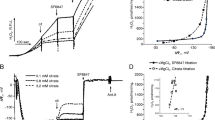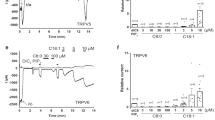Abstract
The inner membrane of freshly isolated mammalian mitochondria is poorly permeable to Cl−. Low, nonlytic concentrations (≤30 μM) of long-chain fatty acids or their branched-chain derivatives increase permeation of Cl− as indicated from rapid large-scale swelling of mitochondria suspended in slightly alkaline KCl medium (supplemented with valinomycin). Myristic, palmitic, or 5-doxylstearic acid are powerful inducers of Cl− permeation, whereas lauric, phytanic, stearic, or 16-doxylstearic acid stimulate Cl− permeation in a lesser extent. Fatty acid-induced Cl− permeation across the inner membrane correlates well with the property of nonesterified fatty acids to release endogenous Mg2+ from mitochondria. Myristic acid stimulates anion permeation in a selective manner, similar as was described for A23187, an activator of the inner membrane anion channel (IMAC). Myristic acid-induced Cl− permeation is blocked by low concentrations of tributyltin chloride (IC50≈1.5 nmol/mg protein). Moreover, myristic acid activates a transmembrane ion current in patch-clamped mitoplasts (mitochondria with the outer membrane removed) exposed to alkaline KCl medium. This current is best ascribed to the opening of an ion channel with a single-channel conductance of 108 pS. We propose that long-chain fatty acids can activate IMAC by withdrawal of Mg2+ from intrinsic binding sites.
Similar content being viewed by others
REFERENCES
Antonenko, Y. N., Smith, D., Kinnally, K. W., and Tedeschi, H. (1994). Biochim. Biophys. Acta 1194, 247-254.
Beavis, A. D. (1992). J. Bioenerg. Biomembr. 24, 77-90.
Beavis, A. D., and Garlid, K. D. (1987). J. Biol. Chem. 262, 15085-15093.
Beavis, A. D., and Powers, M. F. (1989). J. Biol. Chem. 264, 17148-17155.
Bernardi, P. (1999). Physiol. Rev. 79, 1127-1155.
Bernardi, P., Angrilli, A., Ambrosin, V., and Azzone, G. F. (1989). J. Biol. Chem. 264, 18902-18906.
Bernardi, P., Penzo, D., and Wojtczak, L. (2002). Vitam. Horm. 65, 97-126.
Borecký, J., Ježek, P., and Siemen, D. (1997). J. Biol. Chem. 272, 19282-19289.
Brierleý, G. P., Baysal, K., and Jung, D. W. (1994). J. Bioenerg. Biomembr. 26, 26519-26526.
Crompton, M., Ellinger, H., and Costi, A. (1988). Biochem. J. 255, 357-360.
Garlid, K. D. (1980). J. Biol. Chem. 255, 11273-11279.
Gutknecht, J. (1987). Biochim. Biophys. Acta 898, 97-108.
Inoue, I., Nagase, H., Kishi, K., and Higuti, T. (1991). Nature 352, 244-247.
Loupatatzis, C., Seitz, G., Schönfeld, P., Lang, F., and Siemen, D. (2002). Cell Physiol. Biochem. 12, 269-278.
Mitchell, P. (1961). Nature 191, 144-148.
Powers, M. F., and Beavis, A. D. (1991). J. Biol. Chem. 266, 17250-17256.
Schönfeld, P., and Bohnensack, R. (1997). FEBS Lett. 420, 167-170.
Schönfeld, P., Gerke, S., Bohnensack, R., and Wojtczak, L. (2003). Biochim. Biophys. Acta. 1604, 125-133.
Schönfeld, P., Schlüter, T., Schüttig, R., and Bohnensack, R. (2001). FEBS Lett. 491, 45-49.
Schönfeld, P., Schüttig, R., and Wojtczak, L. (2002). Arch. Biochem. Biophys. 403, 16-24.
Schönfeld, P., Wieckowski, M. R., and Wojtczak, L. (2000). FEBS Lett. 471, 108-112.
Siemen, D., Loupatatzis, C., Borecky, J., Gulbins, E., and Lang, F. (1999). Biochem. Biophys. Res. Commun. 257, 549-554.
Shinohara, Y., Unami, A., Teshima, M., Nishida, H., van Dam, K., and Teradam, H. (1995). Biochim. Biophys. Acta. 1228, 229-234.
Wojtczak, L., Wieckowski, M. R., and Schönfeld, P. (1998). Arch. Biochem. Biophys. 357, 76-84.
Xu, W., Liu, Y., Wang, S., McDonald, T., Van Eyk, J. E., Sidor, A., and O'Rourke, B. (2002). Science 298 (5595), 1029-1033.
Author information
Authors and Affiliations
Rights and permissions
About this article
Cite this article
Schönfeld, P., Sayeed, I., Bohnensack, R. et al. Fatty Acids Induce Chloride Permeation in Rat Liver Mitochondria by Activation of the Inner Membrane Anion Channel (IMAC). J Bioenerg Biomembr 36, 241–248 (2004). https://doi.org/10.1023/B:JOBB.0000031975.72350.c6
Issue Date:
DOI: https://doi.org/10.1023/B:JOBB.0000031975.72350.c6




